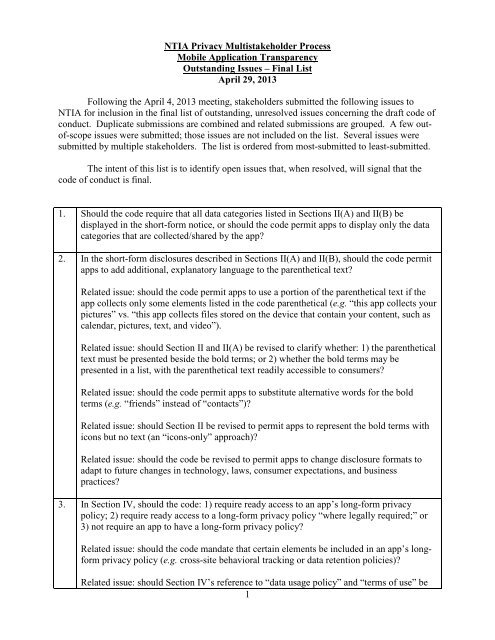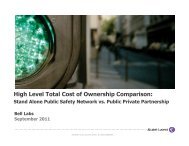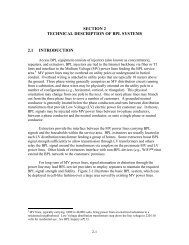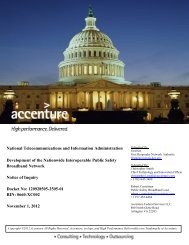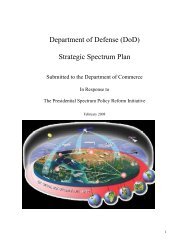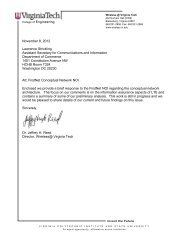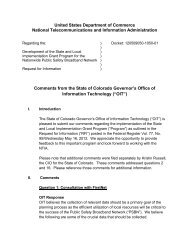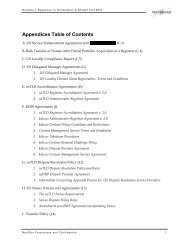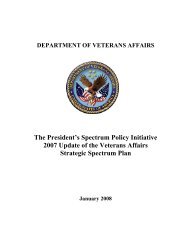Final Outstanding Issues List
Final Outstanding Issues List
Final Outstanding Issues List
Create successful ePaper yourself
Turn your PDF publications into a flip-book with our unique Google optimized e-Paper software.
NTIA Privacy Multistakeholder Process<br />
Mobile Application Transparency<br />
<strong>Outstanding</strong> <strong>Issues</strong> – <strong>Final</strong> <strong>List</strong><br />
April 29, 2013<br />
Following the April 4, 2013 meeting, stakeholders submitted the following issues to<br />
NTIA for inclusion in the final list of outstanding, unresolved issues concerning the draft code of<br />
conduct. Duplicate submissions are combined and related submissions are grouped. A few outof-scope<br />
issues were submitted; those issues are not included on the list. Several issues were<br />
submitted by multiple stakeholders. The list is ordered from most-submitted to least-submitted.<br />
The intent of this list is to identify open issues that, when resolved, will signal that the<br />
code of conduct is final.<br />
1. Should the code require that all data categories listed in Sections II(A) and II(B) be<br />
displayed in the short-form notice, or should the code permit apps to display only the data<br />
categories that are collected/shared by the app<br />
2. In the short-form disclosures described in Sections II(A) and II(B), should the code permit<br />
apps to add additional, explanatory language to the parenthetical text<br />
Related issue: should the code permit apps to use a portion of the parenthetical text if the<br />
app collects only some elements listed in the code parenthetical (e.g. “this app collects your<br />
pictures” vs. “this app collects files stored on the device that contain your content, such as<br />
calendar, pictures, text, and video”).<br />
Related issue: should Section II and II(A) be revised to clarify whether: 1) the parenthetical<br />
text must be presented beside the bold terms; or 2) whether the bold terms may be<br />
presented in a list, with the parenthetical text readily accessible to consumers<br />
Related issue: should the code permit apps to substitute alternative words for the bold<br />
terms (e.g. “friends” instead of “contacts”)<br />
Related issue: should Section II be revised to permit apps to represent the bold terms with<br />
icons but no text (an “icons-only” approach)<br />
Related issue: should the code be revised to permit apps to change disclosure formats to<br />
adapt to future changes in technology, laws, consumer expectations, and business<br />
practices<br />
3. In Section IV, should the code: 1) require ready access to an app’s long-form privacy<br />
policy; 2) require ready access to a long-form privacy policy “where legally required;” or<br />
3) not require an app to have a long-form privacy policy<br />
Related issue: should the code mandate that certain elements be included in an app’s longform<br />
privacy policy (e.g. cross-site behavioral tracking or data retention policies)<br />
Related issue: should Section IV’s reference to “data usage policy” and “terms of use” be<br />
1
deleted<br />
Related issue: should Section IV mandate how an app must “provide ready access” to a<br />
long-form privacy policy, or should the current code language be retained<br />
Related issue: should the title of the code be revised to indicate that code is primarily<br />
focused on short-form privacy notices<br />
4. In Section II(A), should the language regarding de-identification be revised<br />
5. Should the code of conduct include provisions concerning just-in-time-notices<br />
Related issue: Should the code permit just-in-time notices to substitute for disclosures in<br />
the short notice<br />
6. How should data disclosures to business affiliates be treated in the code, specifically in<br />
light of the language in Section II(B) and Section IV<br />
Related issue: should the term “business affiliate” be defined in the code<br />
7. Should the code include language stating that the code does not displace obligations under<br />
existing regulatory or statutory schemes<br />
Related issue: should the code recite relevant, existing laws (e.g. COPPA, Gramm-Leach<br />
Bliley, HIPAA)<br />
8. Should the code be revised to clarify the code’s application to direct collection of data by<br />
mobile ad networks or other third-parties<br />
Related issue: when third-party service providers collect information directly from mobile<br />
app users, should the code limit the app’s disclosure obligations to data collection<br />
authorized by the app<br />
Related issue: should Section II(B) be revised to require disclosure only when apps<br />
“affirmatively share” with third-parties<br />
Related issue: should the code be revised to clarify whether data transfers between app<br />
developers and app providers pursuant to a contract qualify as “sharing” under Section<br />
II(B)<br />
9. In Section I, should the language “app developers should make a good faith effort to<br />
provide consumers with access to the short notice prior to download or purchase of the<br />
app” be revised<br />
Related issue: Should the code address the disclosure practices of mobile app platforms<br />
10. In Section II(A), should the language regarding data that is “actively submitted by a user<br />
through an open field” be revised<br />
2
11. In Section III(E), should the code reference consent obligations established by existing<br />
laws and regulations concerning material, retroactive changes to data collection/sharing<br />
practices<br />
Related issue: should the code be revised to indicate that a notice of material, retroactive<br />
changes needs to be presented for a reasonable period of time<br />
Related issue: should the code clarify whether apps must provide a notice of material,<br />
retroactive changes if the change is made by a third-party plug-in<br />
Related issue: should the code require notice of all retroactive changes, or only changes<br />
that result in expanded or unexpected collection or use of data<br />
Related issue: should the code be revised to focus disclosures concerning changes to<br />
privacy policy on existing app users when feasible<br />
12. Should the Section II(A) be revised to include notice when an app collects a user’s email<br />
address, phone number, name, date of birth, or device ID<br />
13. Should Section II(iii) be revised to clarify the disclosure obligations regarding apps that<br />
share device-specific data<br />
Related issue: should the disclosure obligations be different if the app uses persistent<br />
device IDs vs. pseudonymous device IDs<br />
14. Should the code be revised to make a distinction between: 1) data collection and sharing<br />
that is within the expected context of the app; and 2) collection and sharing that is not<br />
within the expected context<br />
15. Should the code be revised to clarify whether the preamble is operational<br />
Related issue: should the preamble be retained, revised, or deleted<br />
16. In Section II(A) should “browser history” be split from “phone or text log”<br />
17. Should the language in Section II(A) be revised to clarify whether “collected” includes<br />
data that is accessed, but not stored, by an app<br />
18. Should the code be revised to require disclosure of data sharing under Section II(B) only<br />
when the data categories specified in Section II(A) is shared<br />
Related issue: In Section II(B), should the code be revised to clarify to users how the<br />
Section II(A) categories and II(B) categories are (or are not) linked<br />
19. Should the code be revised to clarify whether data collected for crash reporting triggers<br />
disclosure obligations<br />
3
20. In Section IV, should the code require or suggest that companies’ long-form privacy<br />
disclosures identify specific business affiliates with whom data is share<br />
21. In Section II(A), should “financial information” be limited to financial account<br />
information<br />
22. In Section II(A), should “location” specify device location<br />
23. In Section II(A), should the definition of “consumer data resellers” be revised<br />
24. In Sections II(B)(ii) and IV, should the phrase “services rendered” be clarified<br />
Related issue: should Section IV be clarified regarding the relationship between affiliates,<br />
third-parties, app developers, and the contractual relationships between these entities<br />
25. In Section III(D), should the code be revised to clarify whether apps are required to present<br />
full screens or request a click-through at any point<br />
26. Should the code be revised to clarify whether the code imposes obligations concerning<br />
consumer access to data collected or shared by apps<br />
27. Should the code be revised to limit adopters’ potential liability exposure<br />
28. How does the code incorporate the concept of privacy by design<br />
29. Should the code be revised to actually address the contemporary mobile app marketing<br />
environment<br />
30. Should the code be revised to establish a process for updating the code in the future<br />
31. In Section II(B), should entity types be disclosed to consumers, or should the degree of<br />
third party sharing be disclosed instead E.g. “no third party sharing,” “sharing directly<br />
with third parties but no further disclosure,” or “sharing directly with third parties plus<br />
further disclosure by those third parties to others.”<br />
32. Should the applicability of the code of conduct to “mobile” applications, and the potential<br />
applicability of the code to other (i.e. non-mobile) applications, be discussed in Section I<br />
4


